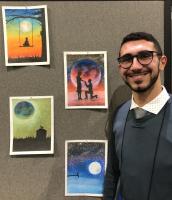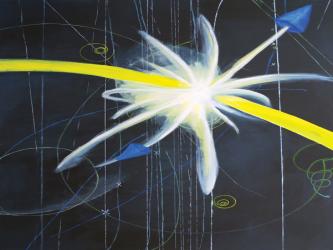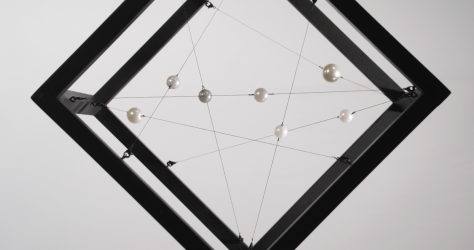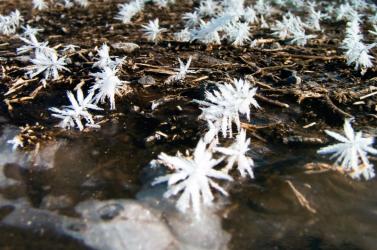
Are you interested in showing off your science-inspired artwork? Submit to display your work of art at the 2022 Physics Congress! The Physics Phine Art Contest looks to highlight the different talents of those in the physics community. Drawings, painting, performances, videos, and more are all acceptable submissions to be judged at the 2022 Physics Congress!
Overview of the Contest
- Artwork must be original and submitted by the artist.

- Submissions of any type of visual art, such as paintings, drawings, photographs, holograms, and sculptures are invited from any Congress attendee. Dynamic (time-based) art, such as performance and electronic works, are also welcome to be submitted. Collaborative projects, particularly those by SPS or ΣΠΣ Chapters, are also invited.
- Entrants may submit multiple works of art, either individually or as part of group submissions.
- Submitted artwork will be categorized into the following themes:
- 100 Years of Momentum
- 4 pillars of Sigma Pi Sigma
- General Science
- Physics for Everyone
- Open (Non-Themed)
- If we receive fewer than five submissions for a particular theme, the theme may be dissolved in the General Science category
- Artwork must be accompanied by a printed description of the work and (except for the Open category) a summary of how the work exemplifies the theme for which it is submitted.
- Summaries should be no longer than 250 words.
- Summaries must be provided by the artistand be no larger than a 4 x 6” index card.
- Summaries should be printed or mounted on a stiff backing to be placed next to the artwork.
- Awards for the winners include: $300 for Best in Show, $300 for People's Choice, and $100 for the top in each category, prints by our esteemed judges, and a book by Fred Dylla, former CEO of AIP and Art Contest judge.
All artwork submissions and summaries must adhere to the Physics Congress 2022 Code of Conduct. Work that violates the code, or its spirit, or is otherwise deemed offensive by the PhysCon Phine Art Committee will be removed from display and from the competition.
Specifications by type of artwork
2D Artwork
- Must be mounted separately on a stiff backing (e.g. cardboard, poster board, foamboard, or some similar material) to which the organizers can adhere strips of Velcro tape for hanging.
- Must be able to be hung as described above without damage to the work; protrusions can extend no more than 4" from the back edge of the backing.
- Must be no larger than 11” x 14”, including the backing, unless an exception is requested and granted. (Email sps-programs [at] aip.org () to obtain an exception.)
3D artwork
- Must weigh no more than 50 lbs.
- Must fit on a 2 ft by 2 ft table top, unless an exception is requested and granted. (Email sps-programs [at] aip.org to obtain an exception.)
Dynamic (time-dependent) artwork
- Must be pre-recorded and available on a webpage with a scannable QR code. The QR code will be printed and displayed in the Phine Art Exhibit Hall next to the summary provided by the artist, for viewers to access on their phones and other devices.
- If you want to bring your own equipment to display, make arrangements by emailing sps-programs [at] aip.org.
- May be performed during the closing Phestival, on a stage dedicated to Phine Dynamic Art, if arrangements are made in advance. To reserve your time slot on the stage, email sps-programs [at] aip.org.
Contest Logistics
- Phine Artists must fill out the on-line submission form at https://physcon2022.completereg.com/ by September 19, 2022.
- Submissions by students will be automatically entered into the contest and eligible for prizes, unless the artist indicates on the registration form that the work is for exhibit only. Non-students are welcome to exhibit their work but will not be eligible for prizes.
- Phine Artists are responsible for transporting their artwork to the Congress.
- Phine Artists must bring their work to the Phine Art Exhibit Hall for hanging/placement during one of two designated times on Thursday or Friday (6:30-7 PM Thursday, 7:30-8:00 AM Friday). Work that is not placed during the scheduled times may not be judged.
Artwork will be on display throughout the Congress and must be removed at the end of the Chapter Showcase (1:00 PM on Saturday).
Get Inspired!
Get inspired by works of art from previous congresses below!
Radiant Twilight by Brian Ross, Grove City College, 2019 Physics Congress
My painting, "Radiant Twilight" is a view from Saturn of the Crab Nebula (Messier 1, NGC 1952, Taurus A, Sh2-244), the remains of a supernova residing within the Taurus constellation. The nebula is home to a pulsar at its core, PSR B0531+21. A pulsar is a highly magnetized neutron or white dwarf star in rapid rotation, who produce large amounts of electromagnetic radiation, and which formed as result of a supernova. To give perspective, the Crab Pulsar’s beams cycle 30 times per second, and its surrounding wind nebula, or plerion, rotates at relativistic speeds. The Crab Nebula and pulsars in general are relevant to this congress’ theme of ‘Making Waves and Breaking Boundaries’ in their key role in discoveries. The first extrasolar planets were found around a pulsar, PSR B1257+12. Pulsars provided some of the first evidence of gravitational waves, while studying binary pulsar PSR B1913+16. More specifically, the Crab Nebula was the first ever remnant to be identified with a recorded supernova event, being observed by Chinese astronomers in 1054 A.D., providing an interesting look into the evolution of a supernova and its remnants. The Crab Nebula was also the first identified source of ultra-high-energy cosmic rays (A ray with an energy greater than 10^18 electron-volts), and has been used to study the corona of the Sun and the atmosphere of Titan, Saturn's moon, while they occulted the nebula.

Particle Detection in the Search for New Matter by Christopher Frye, University of Central Florida, 2012 Physics Congress
Christopher Frye has analyzed data from a particle detector inside the Large Hadron Collider to develop methods of identifying electrons in collisions. His research plays a role in physicists’ search for new particles such as the Higgs boson. Upon collaborating with Christopher and learning about his research, Emily Daniels set out to capture in one piece the numerous aspects that are involved in the physics explorations at the Large Hadron Collider. Drawing from the past, she used an image of the historical bubble chamber detection of particle collisions as a background laying the foundation for modern day experimentation. Shown as a result of the collision is Cerenkov radiation, a process that is critical in the detection of particles in Christopher’s research. Both collaborators aimed to show the event of a collision itself to give a general audience a visual representation of concepts overlooked by many as nothing but abstract formulas and theories.

Asterism by Caroline Bowen, University of Tennessee, Knoxville, 2016 Physics Congress
"Asterism" is a sculpture depicting the seven stars of the Big Dipper as they actually appear in space, though not to scale. When viewed head-on from the front (designated by the marker on the top left corner of the frame), the stars form the Big Dipper as it appears from here on earth, but as the viewer walks around it and his or her perspective changes, the stars appear to dissolve into a seemingly random 3D configuration. This work is largely an exercise in plotting 3D points through sculptural means: the stars were first plotted in 3D in GeoGebra, the cube drawn around them, and line segments were drawn in connecting edges of the cube and intersecting the stars. The measurements for construction were then taken from this model.

Pirouette by Glenn Marsh, Grove City College, 2012 Physics Congress
Ice Faeries seem to spin on the ground on a frigid morning at about 15-18 degrees Fahrenheit. The ice crystals grew radially from tiny sticks projecting out of frozen mud puddles. Optically darker areas of the ground appeared to promote better formation of the crystals. Unlike the more common `frost flowers’ I have seen, these ice formations were not extruded from the sticks, but were true ice crystals that look like hoarfrost, and yet there was no significant frost anywhere else that morning. A model for the development of these elegant ice crystals is that water wicked up by capillary action through these little porous wooden sticks, saturating them. A slight wind might have gently evaporated the water from these sticks and the surrounding mud puddle, and the water then formed ice crystals directly from the vapor phase onto nucleation centers on the twigs.